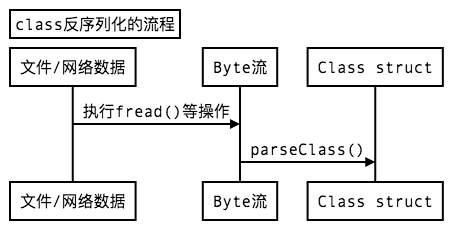Reflection enables program code to access the internal information of classes loaded into the JVM, allowing code to be written and executed instead of selected classes in the source code, trading development efficiency for operational efficiency. the wrist of. This makes reflection a primary tool for building flexible applications.
Reflection can:
Call some private methods to achieve black technology. For example, sending dual-SIM text messages, setting the status bar color, automatically hanging up the phone, etc.
Implement serialization and deserialization, such as PO's ORM, Json parsing, etc.
Achieve cross-platform compatibility, such as the implementation of SocketImpl in JDK
Through xml or annotations, functions such as dependency injection (DI), annotation processing, dynamic proxy, unit testing, etc. are implemented. For example, Retrofit, Spring or Dagger
javapcommand or IDE plug-in.
typedef struct {
u4 magic;/*0xCAFEBABE*/
u2 minor_version; /*网上有表可查*/
u2 major_version; /*网上有表可查*/
u2 constant_pool_count;
cp_info constant_pool[constant_pool_count-1];
u2 access_flags;
u2 this_class;
u2 super_class;
u2 interfaces_count;
u2 interfaces[interfaces_count];
//重要
u2 fields_count;
field_info fields[fields_count];
//重要
u2 methods_count;
method_info methods[methods_count];
u2 attributes_count;
attribute_info attributes[attributes_count];
}ClassBlock;Constant pool (constant pool): Similar to the DATA segment and BSS segment in C, it provides constants, strings, method names and other values or symbols (can be regarded as offset settings) Value pointer) storage
access_flags: flag modification of Class
typedef enum {
ACC_PUBLIC = 0x0001,
ACC_FINAL = 0x0010,
ACC_SUPER = 0x0020,
ACC_INTERFACE = 0x0200,
ACC_ACSTRACT = 0x0400
}AccessFlagthis class/super class/interface: a pointer with length u2, pointing to the constant pool The real address in the link will be dereferenced during the Link phase.
filed: field information, the structure is as follows
typedef struct fieldblock {
char *name;
char *type;
char *signature;
u2 access_flags;
u2 constant;
union {
union {
char data[8];
uintptr_t u;
long long l;
void *p;
int i;
} static_value;
u4 offset;
} u;
} FieldBlock;method: Provide descriptor, access_flags, Code and other indexes, and point to the constant pool:
it The structure is as follows, details here
method_info {
u2 access_flags;
u2 name_index;
//the parameters that the method takes and the
//value that it return
u2 descriptor_index;
u2 attributes_count;
attribute_info attributes[attributes_count];
}
以上具体内容可以参考 JVM文档 周志明的《深入理解Java虚拟机》,少见的国内精品书籍 一些国外教程的解析
The first step is to read and connect through ClassLoader
The second step is to initialize Class
<clinit>().
HashTable<String,Class>internally, which is used to cache the decoded Class byte stream. If there is already a cache in the HashTable, the cache will be returned directly; otherwise , after obtaining the class name, deserialize it into a native C structure in the JVM by reading the class byte stream on the file and network, then malloc the memory, and cache the pointer in the HashTable.
The following is the process of ClassLoader in non-array situations
find/load: Deserialize the file into a C structure. 
Class deserialization process
link: Dereference symbols based on the Class structure constant pool. For example, object calculation memory space, creation of method table, native invoker, interface method table, finalizer function, etc.
<clinit()>(depending on the source code sequence).
public class Sample {
//step.1
static int b = 2;
//step.2
static {
b = 3;
}
public static void main(String[] args) {
Sample s = new Sample();
System.out.println(s.b);
//b=3
}
}
具体参考如下: When and how a Java class is loaded and initialized? The Lifetime of a Type
After the initialization is completed, it is the construction of Object
<init>, which will not be discussed in this article.
Class.forName("java.lang.String").
In the JDK source code implementation, you can find that the native method
forName0()is ultimately called. What it actually calls in the JVM is
findClassFromClassLoader(). The principle is the same as the process of ClassLoader. Same, the specific implementation has been introduced above.
class.getDeclaredFields()method actually calls the native method
getDeclaredFields0(), its main implementation steps in JVM are as follows
According to the Class structure information, obtain the
field_countand
fields[]fields. This field has already been put in during the load process.
Allocate memory and create an array according to the size of
field_count
Perform a forEach loop on the array, and create Object objects sequentially through the information in
fields[]
Return array pointer
主要慢在如下方面 创建、计算、分配数组对象 对字段进行循环赋值
Create Frame
If the object flag is native, hand it over to native_handler for processing
Execute java code in the frame
Pop up the Frame
Return the pointer of the execution result
主要慢在如下方面 需要完全执行ByteCode而缺少JIT等优化 检查参数非常多,这些本来可以在编译器或者加载时完成
Create Object object and allocate space
Call the constructor through Method.invoke (
<init>())
Return Object pointer
主要慢在如下方面 参数检查不能优化或者遗漏的查表 Method.invoke本身耗时
初次学习JVM时,不建议去看Android Art、Hotspot等重量级JVM的实现,它内部的防御代码很多,还有android与libcore、bionic库紧密耦合,以及分层、内联甚至能把编译器的语义分析绕进去,因此找一个教学用的、嵌入式小型的JVM有利于节约自己的时间。因为以前折腾过OpenWrt,听过有大神推荐过jamvm,只有不到200个源文件,非常适合学习。
在工具的选择上,个人推荐SourceInsight。对比了好几个工具clion,vscode,sublime,sourceinsight,只有sourceinsight对索引、符号表的解析最准确。
参考这里
ClassLoader0:native的classloader,在JVM中用C写的,用于加载rt.jar的包,在Java中为空引用。
ExtClassLoader: 用于加载JDK中额外的包,一般不怎么用
AppClassLoader: 加载自己写的或者引用的第三方包,这个最常见
例子如下
//sun.misc.Launcher$AppClassLoader@4b67cf4d
//which class you create or jars from thirdParty
//第一个非常有歧义,但是它的确是AppClassLoader
ClassLoader.getSystemClassLoader();
com.test.App.getClass().getClassLoader();
Class.forName("ccom.test.App").getClassLoader()
//sun.misc.Launcher$ExtClassLoader@66d3c617
//Class loaded in ext jar
Class.forName("sun.net.spi.nameservice.dns.DNSNameService")
//null, class loaded in rt.jar
String.class.getClassLoader()
Class.forName("java.lang.String").getClassLoader()
Class.forName("java.lang.Class").getClassLoader()
Class.forName("apple.launcher.JavaAppLauncher").getClassLoader()最后就是
getContextClassLoader()
,它在Tomcat中使用,通过设置一个临时变量,可以向子类ClassLoader去加载,而不是委托给ParentClassLoader
ClassLoader originalClassLoader = Thread.currentThread().getContextClassLoader();
try {
Thread.currentThread().setContextClassLoader(getClass().getClassLoader());
// call some API that uses reflection without taking ClassLoader param
} finally {
Thread.currentThread().setContextClassLoader(originalClassLoader);
}最后还有一些自定义的ClassLoader,实现加密、压缩、热部署等功能,这个是大坑,晚点再开。
在Stackoverflow上认为反射比较慢的程序员主要有如下看法
验证等防御代码过于繁琐,这一步本来在link阶段,现在却在计算时进行验证
产生很多临时对象,造成GC与计算时间消耗
由于缺少上下文,丢失了很多运行时的优化,比如JIT(它可以看作JVM的重要评测标准之一)
当然,现代JVM也不是非常慢了,它能够对反射代码进行缓存以及通过方法计数器同样实现JIT优化,所以反射不一定慢。
更重要的是,很多情况下,你自己的代码才是限制程序的瓶颈。因此,在开发效率远大于运行效率的的基础上,大胆使用反射,放心开发吧。
以上就是Java反射在JVM的实现 的内容,更多相关内容请关注PHP中文网(m.sbmmt.com)!